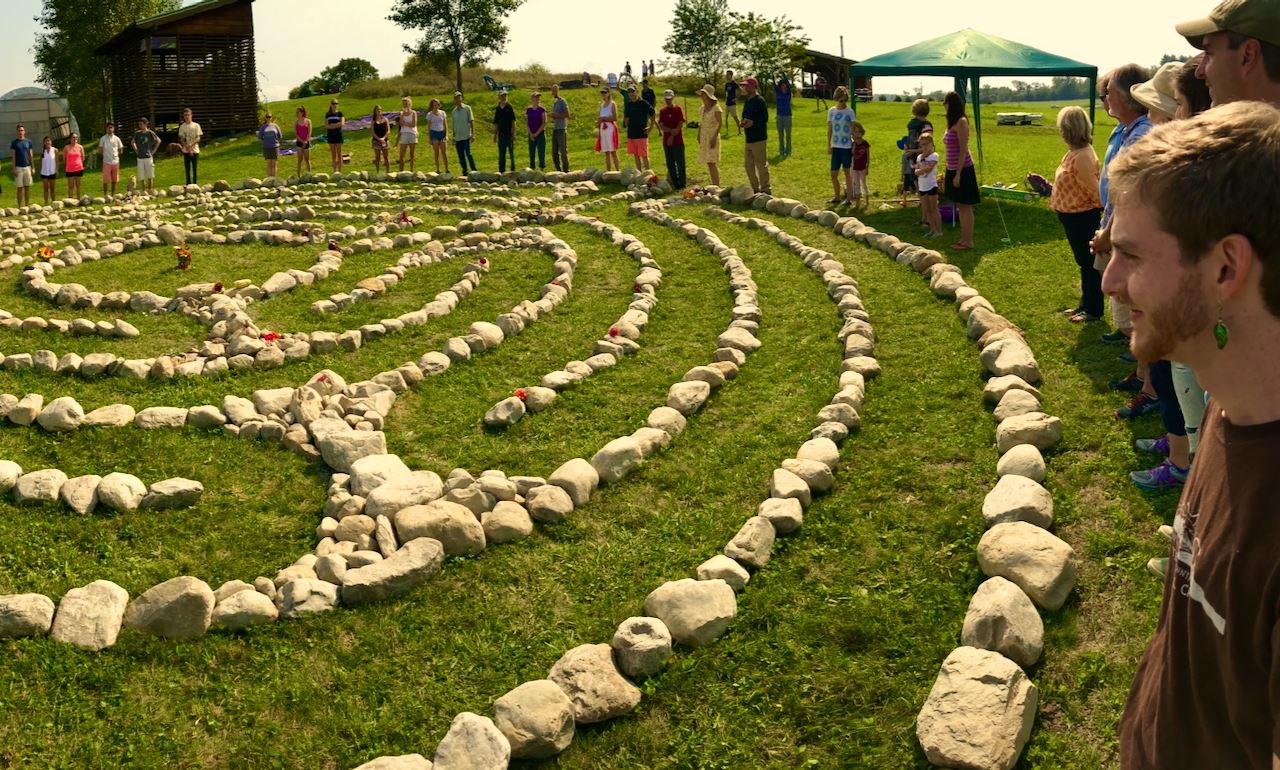
To promote and facilitate the use of labyrinths in higher education
across disciplines and programs.
Labyrinths in Higher Education INITIATIVE
At colleges and universities around the world, labyrinths offer time and space for students, faculty and staff to reflect, relieve stress, and build community. Whether traced with a finger, offered at an event, or installed for everyday use, there are a variety of designs, sizes, and methods for making labyrinths available to everyone.

Middlebury College Labyrinth. Photo by Lars Howlett
Are you a faculty or staff member or administrator charged with finding a way to cohere your college community? Are you a staff development coordinator? Are you in charge of a learning community on your campus? Are you a counselor looking for ways to help students integrate their academic experiences? Are you looking for meaningful across the curriculum academic engagement? Are you a chaplain seeking another tool to use with students and faculty?
You might want to consider how having a labyrinth on your campus can engage all the members of your community in ways that honor the uniqueness of your academic culture while strengthening your institution.
Watch Recordings of Past Webinars
Discover the opportunities and considerations for creating labyrinths on campus, holding events and facilitating group walks in this ongoing series exploring labyrinths in higher education. Click to download our latest comprehensive resource PDF.
- Roundtable including a student perspective, bringing a labyrinth to campus, using the labyrinth for interfaith walks, alumni engagement, student travel tours and the international index of campus labyrinths.
- Integrating Labyrinths in Educational Settings: Celebrating World Labyrinth Day on Campus (Panel discussion)
- Centering Labyrinths in an Academic Environment (with Lars Howlett and Steve Terry)
- Creating Labyrinths on Campus: Part 1 (with Dr. Jan Sellers)
- Creating Labyrinths on Campus: Part 2 (with Lars Howlett)
- Campus Labyrinths: From Idea to Reality (with Dr. Jan Sellers)
- Labyrinths in Higher Education: An Inquiry (Panel discussion)
Access all past webinars with this YouTube video playlist:
 Valuable Resource Books & International Index
Valuable Resource Books & International Index
Click to download: List of Recommended Books on Labyrinths for Libraries
Permanent and Landscaped Labyrinths in Universities and Colleges: An International Index.
This comprehensive new research by Dr. Jan Sellers brings details of university and college labyrinths around the world into a single reference source for the first time. Includes details of over 260 labyrinths in 18 countries, with many links to further information, maps and images. Enjoy the journey!
Available at https://jansellers.com/publications/
Learning with the Labyrinth has proved a valuable resource for many educators, advisers and administrators who are keen to bring a labyrinth to their campus. It is the first ‘mainstream’ book on this topic, part of a Teaching and Learning in Higher Education series, and includes a research overview, free resources to photocopy and many ideas about use of the labyrinth in teaching, guidance, educational development and outreach, from an international range of contributors. Visit the website for a free download of the detailed introductory chapter. Editors: Dr Jan Sellers and Professor Bernard Moss (both of whom are Veriditas facilitators). Now published by Macmillan International Higher Education
Research Resources
The Labyrinth Society General Resources Research Page with Links
TLS Labyrinth Research Committee
Search Results for "Higher Education"
Guidelines for Doing Labyrinth Research
Contemplative Pedagogy
The growing field of Contemplative Pedagogy includes labyrinth walking as one of many methods, as illustrated on the Tree of Contemplative Practices.
Center for Contemplative Mind in Society
Contemplative Pedagogy Network
Example: City University of New York, School of Law: Contemplative Practice of Law, and labyrinth experience
Example: Thompson Rivers University, Canada: Contemplative Practice and Creative Writing

What is a Labyrinth?
Labyrinths are ancient archetypes dating back 4,000 years or more. They usually consist of a meandering design on a singular path that leads from the outer edge in a circuitous way to the center. There are no tricks and no dead ends. Unlike a maze where you can lose your way, the labyrinth is a tool that can help you find your way. Useful for personal, psychological and spiritual transformation, they are also thought to enhance right-brain activity. Labyrinths evoke metaphor, sacred geometry, spiritual pilgrimage, mindfulness, stress-reduction, environmental art, and community building.
Labyrinths can be built from a wide array of materials, can range from simple to more complex, and can be permanent or portable. Labyrinth activities can be one-time, ongoing, seasonal, communal or personal.
|
Interested in having a labyrinth built on your campus? |

Labyrinths are an open source archetype that can be adapted for use depending on the intention, setting, and budget. Temporary labyrinths can be created cheaply and easily with chalk on concrete, paint or ribbon on a lawn, or masking tape indoors. Canvas labyrinths are a good place to start. They can be moved and stored easily. They can be offered for special events, during times of stress or for interfaith religious holidays, and can also be used as a resource for teaching, learning and reflection throughout the year.
For festivals or fundraisers, labyrinths can be created with common objects such as canned food, shoes, books, flowers, or electric tea lights. Semi-permanent labyrinths can be built with organic materials such as wood or stones reclaimed from landscaping.
Permanent labyrinths can be created to enhance or harmonize with the campus environment, a beautiful feature for all to enjoy in the long term. These are often created with precision-cut pavers or stone, or with crushed granite on concrete.
For more information contact Lars Howlett
- To download a brochure containing the above information, please click here.
 A professional Labyrinth Designer and Master Builder, Lars creates site-specific temporary and permanent labyrinths using sacred geometry. Lars is a Veriditas Faculty member offering inspiring lectures and leading transformative workshops to diverse communities. He has designed, built and introduced labyrinths at schools and colleges including Middlebury and Wellesley Colleges. www.DiscoverLabyrinths.com
A professional Labyrinth Designer and Master Builder, Lars creates site-specific temporary and permanent labyrinths using sacred geometry. Lars is a Veriditas Faculty member offering inspiring lectures and leading transformative workshops to diverse communities. He has designed, built and introduced labyrinths at schools and colleges including Middlebury and Wellesley Colleges. www.DiscoverLabyrinths.comInterested in bringing a Veriditas Program to your campus?
Labyrinths come to life when they are cared for and offered by members of the community. Veriditas is the premiere organization for labyrinth workshops. Ranging from introductory workshops of several hours to several days, to more in-depth retreats, Veriditas will customize the workshop to meet your needs. Contact us no matter where your institution is in the process of establishing a labyrinth program. Veriditas workshops include an introductory lecture, guided labyrinth walk, topic lectures, and question-and-answer time.You might also consider adding on a Veriditas Facilitator Training to your workshop. The goal of Facilitator Training is to prepare people to introduce others to the labyrinth in an articulate, professional and effective way. The training addresses both meditative walking and ceremonial use, including leading group walks and workshops. We have also developed a Student Labyrinth Guide Training program with the intention of supporting students in organizing their own walks and labyrinth projects on campus.
For more information and to set up a time to discuss your workshop needs, please email Dawn Matheny at [email protected] or call her at 707-283-0373.This page has resources about the UMass Labyrinth Project.

Above is a the Spring 2021 temporary installation at UMass Amherst.
